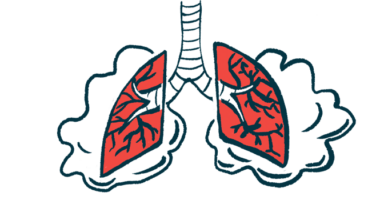Exposure to Air Pollution Particles May Add to CF Clinical Variability
Carbon nanoparticles tied to reduced CFTR protein levels in study

Exposure to carbon nanoparticles — tiny air pollution particles that account for a substantial part of air pollution in urban areas — significantly reduces the levels of CFTR, the faulty protein in cystic fibrosis (CF), according to the results of a new study.
Being exposed to these air pollution particles also increased signs of cellular stress, DNA damage, and cell death.
The study used human airway cells grown at an air-liquid interface and exposed or not to aerosol-delivered carbon nanoparticles.
Its findings suggest exposure to air pollution such as carbon nanoparticles may explain the clinical variability among CF patients, including those carrying the same disease-causing mutation, researchers noted.
Titled “Carbon nanoparticles adversely affect CFTR expression and toxicologically relevant pathways,” the study was published in the journal Scientific Reports.
CF is caused by mutations in the CFTR gene, which provides instructions to produce the protein of the same name. The CFTR protein is typically transported to the cell surface, where it regulates the flow of ions and water across the cell membrane. Such movement of chloride and water is necessary for the production of mucus in the body.
Without a properly working CFTR protein, abnormally thick mucus accumulates in various organs, including the lungs and digestive tract.
High clinical variability — meaning a wide variety of symptoms — is a hallmark of CF, even among patients with the same CFTR mutation. That variability suggests environmental factors such as air pollution may influence disease severity.
“In urban areas, particulate air pollution predominantly consists of ultrafine combustion-derived carbon particles,” the researchers wrote, adding that these nanoparticles “are nowadays well recognized to cause adverse effects in lung cells.”
Investigating air pollution effects in CF
Airway cells from CF patients have been shown to be more susceptible to nanoparticle uptake and accumulation than those from people without the disease.
Previous research showed that the damaging effects of carbon nanoparticles are linked to inflammation and oxidative stress, a type of cellular damage implicated in CF.
Oxidative stress results from an imbalance between the production of potentially damaging molecules, called reactive oxygen species, and cells’ ability to detoxify them with antioxidants.
“Besides DNA damaging effects, intracellular reactive oxygen species can trigger signaling cascades which lead to the production and release of pro-inflammatory [molecules],” the researchers wrote.
Exposure to cigarette smoke has been shown to reduce CFTR production in human airway cells, but little is known about the specific effect of carbon nanoparticles on these cells, including in CFTR levels.
To address this, a team of researchers in Germany evaluated the effects of pure carbon nanoparticles on human bronchial epithelial cells grown at an air-liquid interface. Bronchial epithelial cells, those lining the main passageways into the lungs, form the interface between the external and internal airway environment.
Results showed a four-hour exposure to aerosol-delivered carbon nanoparticles impaired the integrity of the cells’ natural barrier when compared with before exposure.
Carbon nanoparticle exposure also significantly reduced both the activity of the CFTR gene and CFTR protein levels by about 40% relative to exposure to clean air. A significant reduction in the activity levels of two CF genetic modifiers — TMEM16A by 60% and TNFAIP3 by 70% — also was observed.
Genetic modifiers are genes or genetic variants that can increase or reduce the severity of a condition without necessarily causing the disease themselves. TMEM16A encodes a protein shown to be critical to CFTR’s presence in the cell membrane. Meanwhile, lower TNFAIP3 activity has been associated with worse lung function in CF patients.
Further analyses showed exposure to carbon nanoparticles also was associated with increased signs of oxidative stress, cell death, and DNA damage. This was assessed by the increased activity of genes linked to such processes.
Notably, “exposure to the nitrogen-air mixture alone did neither influence barrier integrity nor gene [activity], indicating that the observed effects are particle related,” the researchers wrote.
These findings highlight that exposure to aerosol-delivered carbon nanoparticles reduces barrier integrity and CFTR protein levels, while promoting oxidative stress, DNA damage, and cell death in lab-grown human airway cells.
“These effects, due to environmental factors, might explain the development of different [clinical] severity in patients carrying the same CFTR mutation,” the team wrote.
Further studies are needed to confirm this association and understand the mechanisms behind carbon nanoparticle-induced reduced CFTR levels and increased cellular stress, damage, and death, the researchers noted.








